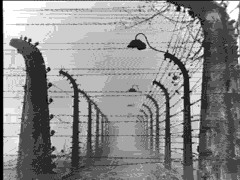
|
Jews were forced to where these yellow stars to identify
them as enemies of the state. The Minister of propaganda Paul Josef
Goebbels used slogans of hate along with these symbols to osstacize the
Jews and heard them into Ghettos.
|
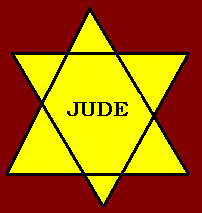
|
|
|

|
|
|
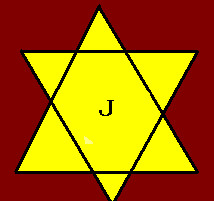
|
Discrimination and Isolation did not end with the Jews. The
Nazis targeted other ethnic groups with the same type of hateful
propaganda and inhumane atrocities.
|
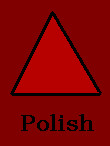
|
During WW II Poland suffered greatly under five years of German occupation.
Nazi ideology viewed "Poles"--who were a predominantly Roman Catholic ethnic
majority--as "subhuman" people occupying lands vital to Germany.
German forces invaded Poland on Sept 1, 1939.
|
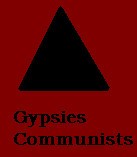
|
Between 1939 and 1945 "Gypsies" suffered greatly as victims of Nazi
persecution and genocide. Nazi's viewed them as racial inferiors.
The Third Reich viewed them as a threat to the "racial purity" Hitler was
trying to establish in Germany.
|

|
Those who spoke out against the Nazi's and their atrocities were arrested
and labeled criminals. They too were forced to wear an identifying
patch. Since they were usually not of an unacceptable ethnic
group, they were not treated as badly in the concentration camps.
Usually there were more "green badges" in better camp jobs.
|
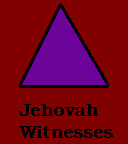
|
This religious group was started in the United States during the 18970's.
During the 1890's missionaries were sent to Germany. By the 1930's
only 20,000 Germans had converted to this religion. These
brave German's were brave enough to speak out against the Nazi regime.
There were severely persecuted in the concentration camps. They
distinction over their imprisonment and those of the other persecuted groups,
was that all they had to do to escape being sent to the concentration camps
was to renounce their faith. Even under the persecution and maltreatment
of the concentration camps they refused to renounce their beliefs.
|
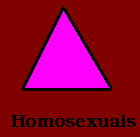
|
| As part of the Nazis' attempt to purify German society and create a
master Aryan race, the Nazis condemned homosexuals as socially aberrant.
Hitler banned all homosexual and lesbian organizations and raided their
gathering places. There was even a special division of the Gestapo
set up to investigate suspected homosexuals. Anyone suspected of
being a homosexual or lesbian was put on a "pink list". |
|
|
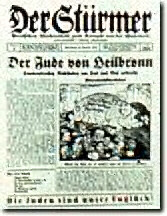 The headline in this German newspaper reads:
"The Jews Are Our Misfortune"
The headline in this German newspaper reads:
"The Jews Are Our Misfortune"
|
|

|
|
President Franklin Delano Roosevelt, USA
|
|
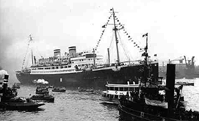
|
| US St Louis--The Luxury liner carrying over 900 Jewish refugees
fleeing Germany and seeking asylum in the United States or Cuba.
Both nations denied the ship to allow the passengers to disembark.
The ship was forced to return to Germany. The passengers
were all seized by the Nazis and sent to concentration camps. |
| |
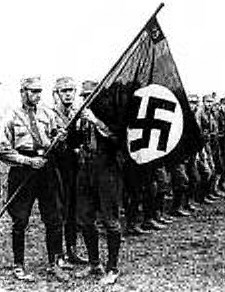
|
| The Nazi Flag-- The symbol of the Third Reich The swastika, the
symbol of death the symbol that was worn by those who terrorized innocent
people in the name of "racial purity". |
| |
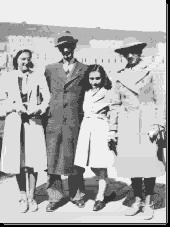
|
| Porbably the most well know story from the Holocaust Era, is
"The Diary of Anne Frank.." The story is about a family of German-Jews
who go into hiding. Many families tried to excape the Ghettos and
the concentration camps by hiding. The Franks hid in Holland. |
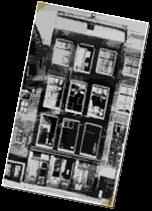
|
| The above is a picture of the annex where the Franks hid until they
were dicoverd by Nazi police. |
|
|
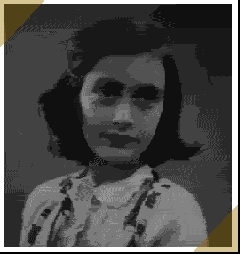
|
|
Anne
Frank
"The Diary
of Anne Frank" is a personal account of a Jewish family hiding
from Nazi persecution during WWII. They were discovered and
takent to Weteringschans Prison, they remained there until August 8, when
the Frank family was moved to Westerbork transit camp. They remained
there for nearly a month, until September 3, when they were transported
to the Auschwitz
death camp in Poland. It was the last Auschwitz-bound transport ever to
leave Westerbork. Otto Frank (Anne's father) was the only member of the
family to survive. Anne Frank died in Auschwitz shortly before the
Allied Liberation of Europe. |
|
-
Allies: Twenty-six nations led by Britain, the United States, and the Soviet
Union that joined in the war against Nazi Germany, Italy, Japan, and their
allies, known as the Axis.
-
Anti-semitism:
Word coined in the 19th century for Prejudices toward Jews and discrimination
against them.
-
Arvan: Originally a term for peoples speaking the languages of Europe and
India. Corrupted by the Nazis, who viewed those of Germanic background
as the best and purist examples of "superior Aryan race."
-
Auschwitz-Birkenau:
Largest Nazi death camp, located 37 miles west of Cracow, Poland. Established
in 1940 as a concentration camp, it extended its activities to a killing
center at Birkenau in 1942. Also part of the huge camp complex was the
I. G. Farben slave labor camp, known as Buna-Monowitz.
-
Baba Yar--a
ravine, situated in the northwestern part of Kiev, where the Jews of the
Ukrainian capital were systematically massacred. At the southern end of
the ravine were two cemeteries, one of which was Jewish. On September
29-30, 1941, more than 33,000 Jewish residents of Kiev were marched to
this and systematically gunned down over the edge of the ravine by members
of the Sonderkommando 4a of Einstazgruppen C. Thousands of Gypsies and
Soviet POWs were also executed at this site between 1941 and 1943.
-
Belzec: Nazi death camp in eastern Poland where an estimated 550,000 Jews
were killed between March, 1942 and December, 1942. Earlier Belzec functioned
as a slave labor camp.
-
Bergen-Belsen: Located in nor-them Germany, transformed from a prisoner
exchange camp into a concentration camp in March, 1944. Poor sanitary conditions,
epidemics, no medical assistance, slave labor, and starvation led to tens
of thousand of deaths, including Anne and Margot Frank in March 1945.
-
Buchenwald: Concentration camp In central Germany, established in July
, 1937. One of the largest concentration camps on German soil with more
than 130 satellite slave labor camps. It held many political prisoners.
More than 65,000 prisoners perished here.
-
Bystanders: Those who stand by while a crime or wrongful deed is being
committed, those who do not actively participate in the deed but who do
nothing to stop it, who do not protest, who look the other way.
-
Chancellor: Chief (prime) minister of Germany. Head of Government.
-
Chelmno:
Nazi death camp in western Poland where more than 150,000 documented Jews,
about 5,000 Gypsies, and several hundred Poles and Soviet prisoners
of war were killed between December 1941 and March 1943 and between April
and August of 1944.
-
Concentration Camps:
In German, Konzentrationslager. Prison camps constructed to hold Jews,
Gypsies, political and religious opponents, resisters, homosexuals, and
others whom the Germans considered 'enemies of the state." More than 100
concentration camps were created across German-occupied Europe.
-
Dachau:
First concentration camp, established in March, 1933 near Munich, Germany.
At first Dachau held only political prisoners, but over time, more and
more groups were imprisoned there. Deaths at Dachau occurred through torture,
starvation, disease, and overwork on a minimal diet.
-
Death Camps: Term
used to describe those camps that came to be used solely for the purposes
of extermination: Auschwitz-Birkenau, Treblinka, Belzec, Sobibor, Maidanek
-- where people were murdered in assembly Iine style by gassing, though
many also died there from medical experiments, deliberate maltreatment,
hangings, bumburninging, starvation, etc.
-
Discrimination: A distinction made in the treatment of others based upon
prejudice -- or prejudging. An act against others or a policy directed
against others because of their differences, or because of the differences
the discriminators are prejudiced against.
-
Drancy: Located near Parts, Drancy became the largest transit camp for
deportation of Jews from France. Between July, 1942, and August, 1944,
more than 61,000 were sent from Drancy to Auschwitz-Birkenau for extermination.
-
Eichmann,
Adolph (1906-1962): SS Lieutenant Colonel and head of the Gestapo department
dealing with Jewish affairs. He organized transports of Jews from all over
Europe. to Nazi death and concentration camps. After the war, he escaped
into South America. Captured by the Israeli Secret Service in Argentina,
he was brought to Israel for trial He was tried in Jerusalem in 196 1,
convicted, and executed.
-
Einsatzgruppen:
Mobile
killing units of SS and SD (Security Service), which followed German
units into the Soviet Union in June, 1941, with orders to murder all Jews,
as well as Communist leaders and Gypsies.
-
Extermination Camps: Another term for Death Camps. More than 2,700,000
Jews were exterminated at these camps, along with thousand of Gypsies,
Soviet prisoners of war, Poles and others.
-
Final Solution: Term used by the Germans and coined at the Wannsee Conference
in 1942, and refers to the 'Final solution of the Jewish question in Europe."
It was the German code for the physical and total destruction of Jews in
Europe.
-
Frank, Anne
(1929-1945): Born in Frankfurt, Germany. In 1933, she moved with her
family to Amsterdam, Holland. On July 6, 1942, they went into hiding and,
helped by Miep Gies, remained in hiding until their arrest by Gestapo on
August 4, 1944. They were held at the Westerbrook transit camp from August
8, 1944, until September 3, 1944, when they were deported to schwitz-Birkenau.
Anne's mother, Edith Frank, perished there on January 6, 1945. Anne and
her sister Margot were transferred to Bergen-Belsen in late October, 1944,
and they both died there of typhus in March, 1945. Anne's father, Otto,
survived and oversaw the publication of Anne's
diary.
-
Genocide: Deliberate, systematic destruction of a racial, cultural, ethnic,
or political group.
-
Gestapo: In German, Geheime Staatspolizei, Secret State Police.
-
Ghettos--Jews
were forced to live in ghettos during WWII. They functioned as a transition
before the Jews were deported to their deaths. The first ghetto was set
up in Piotrkow, Poland in 1939. The Warsaw
ghetto was Europe's largest, housing about four hundred and forty five
thousand Jews. The death rate in the ghettos was very high due to starvation
and disease.
-
Goebbels,
Paul Josef (1897-1945): Minister of Propaganda in Nazi Germany, who
was close to Hitler. At the end of the war, Goebbels and his wife took
their own lives and those of their children in the same bunker in which
Hitler took his life.
-
Gypsies: Popular term for Roma and Sinti, nomadic people believed to have
come from northwest India. Traveling mostly in small caravans, Gypsies
first appeared in western Europe in the 1400s and eventually spread to
every country of Europe. Prejudices toward Gypsies were and continue to
be widespread. Approximately 250,000 to 500,000 Gypsies are believed to
have perished in the Nazi concentration camps, killing centers, and in
Einsatzgruppen and other shootings. As with the Jews, many were also killed
by local, native populations of many eastern European countries.
-
Heydrich, Reinhard (1904-1942): SS Lieutenant General, head of the Reich
Security, which included the Gestapo. Organized the Einsatzgruppen, or
killing squads, and led the Wannsee Conference of 1942, where the coordination
of the "final solution" was discussed. He was shot by members of the Czech
resistance on May 27, 1942, near Prague, and died several days later. To
honor Heydrich, Germans gave the code name "Operation Heydrich" to the
destruction of Jews in occupied Poland at Belzec, Sobibor, and Treblinka
extermination camps.
-
Himmler,
Heinrich (1900-1945): Reich leader of the SS from 1929 to 1945, during
World War II, he was head of the vast empire of all SS formations, police
forces, concentration, labor, and death camps, and, after Hitler, was the
major architect of the "final solution" to exterminate Europe's Jews. He
was responsible for carrying out the "final solution." He committed suicide
before he could be brought to trial.
-
Hitler,
Adolph: Leader of Germany's Third Reich from 1933 to 1945.
-
Holocaust: Literal definition: a "burning whole," in other words, by fire.
Coined by the Jewish community and Jewish writers and historians and refers
to a specific event in the 20th century: the systematic, deliberate, bureaucratic
destruction of more than 6 million Jews in Europe by the German Nazi regime
and their collaborators as a central act of state, an act of government
policy, before and during World War II.
-
Jehovah's Witnesses: Religious sect that originated in the United States
and had about 20,000 members in Germany in 1933. Witnesses, whose religious
beliefs did not allow them to swear allegiance to any worldly power, were
persecuted as "enemies of the state." About 10,000 Witnesses from Germany
and other countries were imprisoned in concentration camps. Of these about
2,500 died.
-
Jewish Council: In German, Judenrat. Council of Jewish leaders established
on Nazi orders in German-occupied towns and cities.
-
Juden: German word for Jews."
-
Killing Centers: Death camps equipped with facilities to kill with poisonous
gas. Belzec, Chelmno, Sobibor, Treblinka, Maidanck, and Auschwitz-Birkenau.
-
Kristallnacht: As revenge for the murder of the German diplomat, Ernst
vom Rath, Josef Goebbels coordinated a nationwide night of antisemitic
terror, subsequently known as Kristallnacht (Night of Broken Glass). On
the night of November 9, 1938, synagogues were burned, Jewish shops looted,
Jewish homes vandalized, Jews were beaten and abused. Ninety-one were murdered
and 30,000 Jewish men were arrested and sent to concentration camps.
-
Lodz:
Before WW II, a major industrial city in western Poland with a large Jewish
population, second only to Warsaw's. In April, 1940, the first major ghetto
created by the Germans was at Lodz. Some 43,000 persons died in that ghetto
from starvation, disease, and exposure to the cold. Thousands more were
taken from the ghetto to be gassed at Chelmno. In August-September, 1944,
the 60,000 remaining Jews were sent to Auschwitz-Birkenau for extermination.
-
Maidanek: Located near Lublin in Poland, at first a labor camp for Poles
and Soviet prisoners-of-war, it existed as a concentration camp from April
1943 to July 1944. Tens of thousands perished there from starvation, maltreatment,
and shootings. It was also a killing center where 50,000 Jews were gassed.
-
Mauthausen:
Concentration camp for men near Linz in upper Austria, opened in August,
1938. Many political prisoners were held at Mauthausen and its numerous
sub camps. Classified by the SS as one of the two harshest concentration
camps, many prisoners were killed there by being pushed from 300 foot cliffs
into stone quarries.
-
Mengele,
Josef (1911-1979): Senior SS physician at Auschwitz-Birkenau who carried
out "selections" of prisoners upon arrival at the camp, separating those
assigned to forced labor and those to be killed in the gas chambers. He
also carried out cruel research on
twins deported to the camp and other so-called medical research experiments,
such as separating nursing newborns from mothers to see how long it would
take them to starve to death. After the war, he disappeared. In 1985, a
corpse of a man who had died in a swimming accident in Brazil was identified
as Mengele.
-
Nazi: Short term for National Socialist German Workers Party, a right-wing
nationalistic and anti-semitic political party formed in 1919 and headed
by Adolf Hitler from 1921 to 1945.
-
Occupation: Control of a country taken over by a foreign military power.
-
Palestine: British Mandate of Territory assigned to British control in
1920 by terms of a postwar treaty with defeated Turkey, the British mandate
was ended on May 15, 1948, when, by the terms of the United Nations, the
territory was divided into the State of Israel and the Kingdom of Jordan.
-
Partisan: Member of a resistance group operating secretly within enemy
lines, using hit-and-run guerrilla tactics against occupying forces.
-
Perpetrators: In the Holocaust, those who actively and willingly performed
the crimes against humanity.
-
Persecution: Act of causing others to suffer, especially those who differ
in background or lifestyle or hold different political or religious beliefs.
-
Pogrom: Russian word for "devastation." Organized violence against the
Jews in many European countries, particularly in Russia and Eastern Europe.
-
Prejudice: A prejudgment made before all the facts are known. An opinion
held in disregard of the facts that contradict the judgment. A suspicion,
intolerance, or irrational hatred of other races, creeds, religions, ethnic
groups, homosexuals, the poor, immigrants, etc.
-
Ravensbruck:
Concentration camp for women opened in May of 1939, 56 miles north of Berlin.
An estimated 120,000 prisoners were inmates there, including political
prisoners, Jews, Gypsies, and Jehovah's Witnesses.
-
Reich: German word for "Empire."
-
Reichstag: Germany's lawmaking body, its parliament. •Rhineland: Demilitarized
zone that Allies established after WW I as a buffer between Germany and
western Europe.
-
Roosevelt, Franklin Delano
(1882-1945): Thirty-second president of the United States, serving from
1933 to 1945. His policy of strict isolationism kept
the United States from entering WWII until the bombing of Pearl Harbor
on Dec. 7, 1941.
-
SA: In German, Sturmabteilung, Storm Troopers. Also called "Brownshirts."
Members of a special armed branch of the Nazi party.
-
Scapegoat: Person or group of persons unfairly blamed for wrongs done by
others, as the Jews historically have been used as scapegoats by Christians
and Arabs over many hundreds of years.
-
Shteti: Yiddish word for a small Jewish towm or village in Eastern Europe.
Over 6,000 such communities were systematically wiped out by the Germans
and the culture of those Shtetls lost for all time.
-
Sobibor:
Nazi Germany
extermination camp in Eastern Poland where more than 200,000 Jews were
exterminated between May of 1942 and November of 1944. It was the site
of one of the largest and most heroic camp revolts in WW II.
-
Sonderkommando: German word for "special squad." In the context of extermination
camps, it refers to units of Jewish prisoners forced to take away bodies
of gassed inmates, often members of their own families, to be cremated
and to remove gold fillings and hair. They were always destined to be killed
themselves when their bodies wore out from their labors.
-
SS: In German, Schutzstaffel. Protection Squad Units formed in 1925 as
Hitler's personal body guard. The SS later was built into a giant organization
by Heinrich Himmler. It provided staff for police, camp guards, and military
units (Waffen SS) serving with the German army.
-
Star of David: Star with six points, symbol of the Jewish religion, historically
used by Christians and Arabs as a badge of shame to be worn by Jews.
-
Sudetenland: Mainly German-speaking region that was part of Czechoslovakia
between the two world wars. Annexed by Germany in October of 1938.
-
T-4--The use of lethal
injections to rid Germany of the
handicapped individuals. The determination of who was handicapped
was left up to Nazi doctors in charge of the project. A questionaire
was used to identify potential T-4 individuals.
-
Theresienstadt
(Terezin): Town located about 40 miles from Prague and used by the
Germans as a major ghetto. It was established in 1941 as a "model Jewish
settlement" to show Red Cross investigators how well Jews were being treated.
In reality, behind its false fronts and showcase stores and residences,
many thousands died there of starvation and disease, and thousands more
were deported and killed in extermination camps, including thousands of
children under the age of 16.
-
Treblinka: Extermination
camp about 50 miles northeast of Warsaw. More than 750,000 Jews and
at least 2,000 Gypsies were murdered there between July of 1942 and November
of 1943.
-
Underground: Organized resistance groups.
-
Warsaw: The capital of Poland, where about 350,000 Jews lived on the eve
of WW II. In October-November of 1940, the Germans established the Warsaw
Ghetto, into which some 500,000 Jews were crowded to live and die in cramped,
cold, unsanitary conditions and restricted to approximately 135 calories
of food a day. An average of 5,000 to 6,000 died each month from starvation,
disease, exposure to cold, and shootings. Tens of thousands were transported
from there to Treblinka in 1942, having to walk the distance from the ghetto
to the Umschlagplatz (gathering place or disposition center), where they
were loaded into cattle cars for the trip to the death camp. After an uprising
in the ghetto, organized by resistance fighters, with headquarters at Mila
18, who held off the might of the German army for twenty days, which ended
on May 16, 1943 (and is now annually commemorated by Jews and their friends
throughout the western world), the surviving Jews were deported to death
camps.
-
Weimar Republic: German Republic of 1919-1933, a parliamentary democracy
established after WW I, with its capital in the city of Weimar. It was
overthrown by the Nazis in 1933, after which Hitler came to power.
-
Westerbork: Transit camp in northeastern Holland for almost 100,000 Jews
who were deported between 1942 and 1944 to Auschwitz-Birkenau, Sobibor,
Theresienstadt, and. Bergen-Belsen. Anne Frank and her family were held
there between August 8, 1944, and September 3, 1944, when they were put
on the very last transport to leave there for Auschwitz-Birkenau.
-
Yiddish: A language that combines elements of German and Hebrew, usually
written in Hebrew characters and spoken by Jews chiefly in eastern Europe
and areas to which eastern Europeans have migrated, including parts of
the United States. It is now increasingly used by Jews who wish to preserve
a remnant of the culture of the shtetl and eastern European Jewish life.
|
